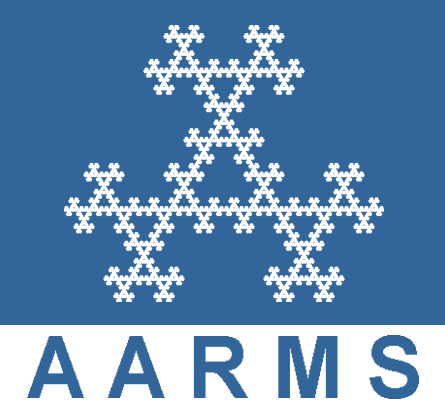Réunion d'hiver SMC 2017
Waterloo, 8 - 11 décembre 2017
Finitude explicite des points entiers sur les courbes hyperboliques
Org: David McKinnon et Jerry Wang (University of Waterloo)
[PDF]
Org: David McKinnon et Jerry Wang (University of Waterloo)
[PDF]
- LEVENT ALPOGE, Princeton University
The average number of rational points on genus two curves is bounded [PDF]
-
We prove that, when genus two curves $C/\mathbb{Q}$ with a marked Weierstrass point are ordered by height, the limsup of the average number of rational points $\#|C(\mathbb{Q})|$ is bounded.
- MIKE BENNETT, University of British Columbia
- NILS BRUIN, Simon Fraser University
Explicit hyperbolicity of nodal surfaces [PDF]
- NILS BRUIN, Simon Fraser University
-
The fact that hyperbolic curves have only finitely many
integral points has various analogues in higher dimensions. For
instance, for complete surfaces, Kobayashi hyperbolicity implies that
there are only finitely many rational curves on the surface. One can
prove that this is the case by exhibiting a regular symmetric
differential on the surface. Furthermore, with multiple such forms it
may be possible to compute a proper algebraic sublocus that must
contain all such curves.
We report on ongoing joint work with Anthony V\'arilly-Alvarado exploring explicit results on the existence of such forms on surfaces given by a model with nodal singularities.
- IMIN CHEN, SFU
A multi-Frey approach to Fermat equations of signature (5,5,p) and (13,13,p) [PDF]
-
The generalized Fermat equation $x^p + y^q = z^r$ is expected to have only trivial primitive integer solutions when $p, q, r \ge 3$. A current approach to this problem is a moduli approach where one attaches to a putative non-trivial primitive solution, a Frey abelian variety. By showing the associated Galois representations are modular, severe constraints on the solutions are obtained. This is the method first pioneered by Wiles' and extended by many mathematicians, including a general program described by Darmon. An important phenomenon that has emerged in recent work is the use of multiple Frey abelian varieties to patch together a complete resolution, not otherwise obtainable by the use of a single Frey abelian variety.
I will report on joint work with Billerey, Dieulefait, and Freitas, where we use a refined application of the multi-Frey method to resolve the equations $x^5 + y^5 = 3 z^p$ (for all primes p) and $x^{13} + y^{13} = 3 z^p$ (for all primes $p \not= 7$) using modular Frey elliptic curves over totally real fields.
- NATHAN GRIEVE, Michigan State University
On measuring the complexity of rational points on projective varieties [PDF]
-
By Faltings' theorem, a hyperbolic curve over a number field admits finitely many rational points. One interpretation of this theorem is that the complexity of approximating rational points on projective varieties should be measured on rational curves. Results in this direction are illustrated by the form of Roth's theorem, for projective varieties, as obtained by McKinnon-Roth. Similar considerations apply in the function field setting. In this talk, I will first explain how Schmidt's Subspace Theorem can be used to establish these forms of Roth's Theorem. Second, I will explain how these results can be interpreted using ideas from toric geometry. In particular, I will explain how these theorems are related to Chow forms and Okounkov bodies.
- JOSEPH GUNTHER, University of Wisconsin-Madison/Orsay
Irrational points on hyperelliptic curves [PDF]
-
We consider genus $g$ hyperelliptic curves over $\mathbb{Q}$ with a marked rational Weierstrass point. If $d < g$ is odd, we prove there exists $B_d$ such that a positive proportion of these curves have at most $B_d$ points of degree $d$. If $d < g$ is even, we similarly bound degree $d$ points not pulled back from points of degree $\frac{d}{2}$ on the projective line. This is joint work with Jackson Morrow.
- AVI KULKARNI, Simon Fraser University
An arithmetic invariant theory of curves from E8 [PDF]
-
Let $k$ be a field of characteristic $0$, let $C/k$ be a uniquely trigonal genus $4$ curve, and let $P \in C(k)$ be a simply ramified point of the uniquely trigonal morphism. We construct an assignment of an orbit of an algebraic group of type $E_8$ acting on a specific variety to each element of $J_C(k)/2$. The algebraic group and variety are independent of the choice of $(C,P)$.
- AARON LEVIN, Michigan State University
Integral points on elliptic curves over function fields [PDF]
-
I will discuss some relations between integral (and rational) points on elliptic curves over functions fields and torsion points on the Jacobians of certain curves, including applications to bounding the number of integral points (or in some cases, exactly counting them). This is based on joint work with Jean Gillibert.
- BETH MALMSKOG, Colorado College
Solving S-unit equations in Sage and Applications to Algebraic Curves. [PDF]
-
Many finiteness and enumerative problems in number theory rely on the finiteness/enumeration of the set of solutions to the equation x+y=1 over the group of S-units in a number field, where S is a finite set of primes. In 1995, Nigel Smart solved certain S-unit equations to enumerate all genus 2 curves defined over the rationals with good reduction away from p=2. Smart's work build on that of of Baker, de Weger, Evertse, Yu, and many others. In 2016, following Smart's methods, Malmskog and Rasmussen found all Picard curves over Q with good reduction away from p=3, and Angelos Koutsianas described methods for enumerating, and in some cases explicitly describes, all elliptic curves defined over a number field with good reduction outside S. Both projects required Sage implementation of special cases of Smart's general method. In January 2017, Alejandra Alvarado, Angelos Koutsianas, Beth Malmskog, Christopher Rasmussen, Christelle Vincent, and Mckenzie West combined these implementations and created new functions to solve the equation x+y=1 over the S-units of a general number field K for any finite set S of primes in K. The code is available on SageTrac and is under review for inclusion in future releases of Sage. This talk will give an overview of motivating problems and applications, the methods involved, and the current state of the implementation.
- ARUL SHANKAR, University of Toronto
Explicit bounds on ranks and integral points of elliptic curves [PDF]
-
The famous theorem of Mordell states that the rank of an elliptic curve over Q is finite. Using this result, Siegel proved that the number of integral points on elliptic curves is finite. In this talk, I will present results that give explicit bounds on the rank and on the number of integral points on an elliptic curve E, in terms of the discriminant of E. These results are joint work with M. Bhargava, T. Taniguchi, F. Thorne, J. Tsimerman, and Y. Zhao.
- IGOR SHPARLINSKI, UNSW
Integer Points on Curves and Density of Points on Curves Modulo p [PDF]
-
We show links between explicit bounds on the number of integer points on curves and bounds on the number of solutions to polynomial congruences that fall in a small box. In particular, we discuss some applications of the Bombieri-Pila bound and outline several open problems.





